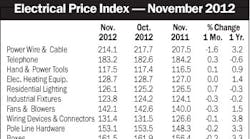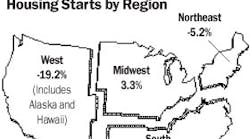Latest from Mag
People - Dec 21, 2012
Obituaries - Dec 21, 2012
November EPI Index Shows No Change
Housing Starts Dip 4% in November
Electrical Marketing - December 21, 2012
Around the Industry - Dec 21, 2012
August construction starts settled back 4 percent from the previous month to a seasonally adjusted annual rate of $573.3 billion, it was reported by McGraw-Hill Construction, New York.
The retreat for total construction was due to a slower pace for nonresidential building after a very strong July, in combination with a slight loss of momentum for residential building and nonbuilding construction (public works and electric utilities). For the first eight months of 2004, total construction on an unadjusted basis came to $394.3 billion, up 10 percent from the same period a year ago.
“Total construction continues to move at a healthy pace, and it’s now virtually certain that full year growth for 2004 will exceed the 5 percent gain in 2003,” stated Robert A. Murray, vice president of economic affairs for McGraw-Hill Construction. “Single-family housing is still exceptionally strong, and the broad trend for commercial building this year is generally upward, even with the reduced amount of construction starts in August. At the same time, tight fiscal conditions over the past several years continue to have a restraining influence on the institutional structure types and public works construction.”
Nonresidential building in August fell 7 percent to $157.7 billion (annual rate). Weaker activity was registered by the major commercial categories — stores, down 4 percent; warehouses, down 7 percent; offices, down 14 percent; and hotels, down 32 percent. Through the first eight months of 2004, the major commercial categories showed these dollar volume gains relative to 2003 — stores and warehouses, each up 2 percent; hotels, up 8 percent; and offices, up 9 percent.
The institutional structure types had a mixed August. Reduced contracting was registered by schools, down 4 percent; amusement-related projects, down 11 percent; transportation terminals, down 13 percent; and public buildings (courthouses and detention facilities) down 17 percent. On the plus side, church construction increased 12 percent, while health-care facilities surged 46 percent, boosted by the start of large hospital projects in Colorado ($130 million), Utah ($123 million), Florida ($78 million), Virginia ($65 million), and California ($60 million). Murray noted, “After experiencing a brief pause during 2003, health-care facilities construction appears to be regaining an upward trend this year. Much of the push is coming from large hospital projects, while contracting for clinics and nursing homes has stayed flat.” The August nonresidential statistics also included a 49 percent drop for manufacturing-related buildings, following the sharp increase for this structure type in July.
Residential building, at $315.5 billion (annual rate), slipped 2 percent in August. Single-family housing was down 3 percent from July, although the level remains very high, up 6 percent from what was reported back in January. The single-family market continues to be supported by low mortgage rates — the 30-year fixed rate averaged 5.9 percent in August, down from 6.1 percent in July, and September has seen this series recede even further to 5.7 percent. Through the first eight months of 2004, single family housing was up 19 percent in dollar terms, and up 12 percent in the number of units. Multifamily housing in August advanced 3 percent, helped by the continued strength for condominiums. The year-to-date figures for multifamily housing show the dollar volume of new construction up 12 percent, although the number of units was down 4 percent. The regional pattern for residential building in August reveals a 4 percent gain in the South Central, but reduced activity in the Northeast and Midwest, each down 1 percent; the West, down 4 percent; and the South Atlantic, down 6 percent.
Nonbuilding construction in August fell 2 percent to $100.1 billion. Public works construction retreated 1 percent, with the loss of momentum coming from the environmental categories — sewers, river/harbor development, and water supply systems. On the plus side, highways and bridges had a strong August, with respective gains of 11 percent and 25 percent. Electric utility construction in August was very weak, falling 52 percent from July.

